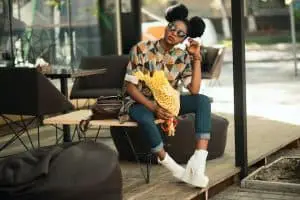Introduction
It’s undeniable that the role of the designer is one of the most appealing in the world of fashion. Even if in many other industries the product designers are outshined by company CEOs, in fashion, designers seem to embody the brand more than anything else. This is still the case in sustainable fashion, but in this case, we could argue that this role seems to entail for more responsibilities than actual benefits. Until a few decades ago, a fashion designer was mostly concerned with:
- The aesthetic of his collections.
- The ergonomy of his designs.
- The fit of the clothing.
- The business viability of a collection.
The last, in particular, was something that was not even a primary concern, as the promotional activities are managed by the marketing department. In any case, all of his responsibilities were connected to his employer, more than to anyone else. Now, things have profoundly changed. By looking at the way a piece of clothing is developed, a designer is forced to trace back his professional responsibilities to a much deeper understanding of the process to create a garment, starting from raw material extraction and leading towards distribution and packaging. In this new perspective, even materials that we tend to give for granted – like cotton – are capable of creating huge unbalances in terms of both human and natural resources.
If a designer wishes to take into account the impact of his work on a grander scale, then undeniably he will be asked to question the very concept of ‘good design’. In this post, we are going to look at 4 different levels of responsibility which are connected to the new role of the designer in a sustainable fashion. Of course, these sets of issues cannot be tackled by a designer alone, but nonetheless, a sustainable designer will be able to set practices and goals in a fashion company, capable of making a difference.
- Social Responsibilities
- Ecological Responsibilities
- Economic Responsibilities
- Cultural Responsibilities
- Conclusions
1. Social Responsibilities
There are at least 4 sets of issues connected with social responsibilities which entail: (1) modern-day slavery (2) human and animal well-being (3) climate change (4) pollution and hazardous chemicals.
It’s now common knowledge that most of the clothing is produced in Latin America and in Asia, where economic conditions allow companies to exploit workers taking advantage of lower wages and poorer working conditions. As we’ve seen in this post: The Importance of the Country of Origin Effect, the ‘Made In’ label has been traditionally associated with the prestige and quality associated with a country’s expertise and craftsmanship. However, when it comes to sustainable fashion, some countries, such as Indonesia and Bangladesh are in many instances carrying the stigma of what has come to be called ‘modern-day slavery’.
A designer, as well as a consumer, can act upon this, by demanding companies to provide transparency regarding the way products are channeled through their production pipeline. In this context, new innovative approaches are developed thanks to the development of blockchain technologies, which use a revolutionary approach to managing information validation by a system of ledgers. It is agreed that blockchain technology, despite being developed in the context of financial transactions is capable of revolutionizing the supply chain.
2. Ecological Responsibilities
This area of responsibilities pertains to 4 main areas of impact on the environment:
- The use of land and the impact on loss of biodiversity.
- The use of water in several stages of the garment production cycle.
- The impact of fashion production as a polluting agent contributing to climate change.
- The use of hazardous chemicals which impact the health of the environment.
Many companies, which are now embracing sustainable policies, are acting on the consequences of their actions, but undeniably, it’s in the design stage that the most sustainable practices can be adopted.
In this article: Fashion Sustainability Through Design Innovation we discuss a variety of initiatives and creative ideas which can be employed to reduce the ecological tax of fashion, by adopting new design strategies.
Luckily, the business case for sustainable fashion has already been established and as a result, the pursuit of eco-friendly designs is demanded by all stakeholders, and from the consumers in particular. Millennials and Generation Z are extremely sensitive to the topic, making any brand interested in engaging the new generations obliged to follow transparent and sustainable practices.
3. Economic Responsibilities
Designers are provided with creative freedom but nonetheless, they are required to justify their choices in the light of the business performance of their companies. These economic responsibilities pertain to how businesses are managed in light of the new trends of sustainable fashion.
As we’ve discussed in other posts such as Understanding How To Build a Sustainable Brand, all businesses are faced with uncertainty and managing uncertainty while being required to radically change a company to embrace new environmental standards is very risky.
This is one of the reasons why the most interesting initiatives in this area are led by larger companies, which are able to manage a higher degree of control over their operations, due to higher resource-pooling capacities. This is also echoed by the growth of the conglomerate company as a widely-used business model in fashion. We discuss business models in fashion in this article.
When it comes to implementing change, larger companies have a competitive advantage and use to attract smaller companies into their ‘areas of influence’ or ownership in order to provide services and consulting which is otherwise inaccessible to smaller company entities.
This, however, should not lead us to a mistake. Bigger is not always better. Even if larger companies are able to better implement sustainability policies, lowering the carbon footprint of their products, this environmental gain can be compensated by the higher volume of production, leaving the carbon footprint, potentially unaltered.
4. Cultural Responsibilities
The cultural responsibilities of a designer are closely connected to the way in which fashion is represented to the consumer. By leveraging a sense of exclusivity and prestige designers alter the perception of their customers. As end-users are themselves part of the supply chain, a sustainable designer is expected to convey environmental values in the way a collection is designed. This allows a firm to project a sense of customer responsibility and accountability that cannot be understated.
Leaving to other times, the portrayal of excesses, sustainability is about new trends in clothing and lifestyle such as minimalism and environmental consciousness. The ultimate sustainable goal for a company is not only that of producing while respecting the environment, but also delivering values that are capable of influencing consumer behavior.
We discuss customer accountability in fashion in greater detail in this post.
5. Conclusions
As we’ve discussed, a designer is now almost a political figure, not only a creative one. Because of his choices, and his ability to impact all of the stakeholders of a company, he has gained a burden of responsibilities that redefines his role in society.
In this sense, new generations of designers will be able to take on these new tasks and lead their companies to lasting changes, making their supply chain and production lines more sustainable in the interest of both internal and external stakeholders.







